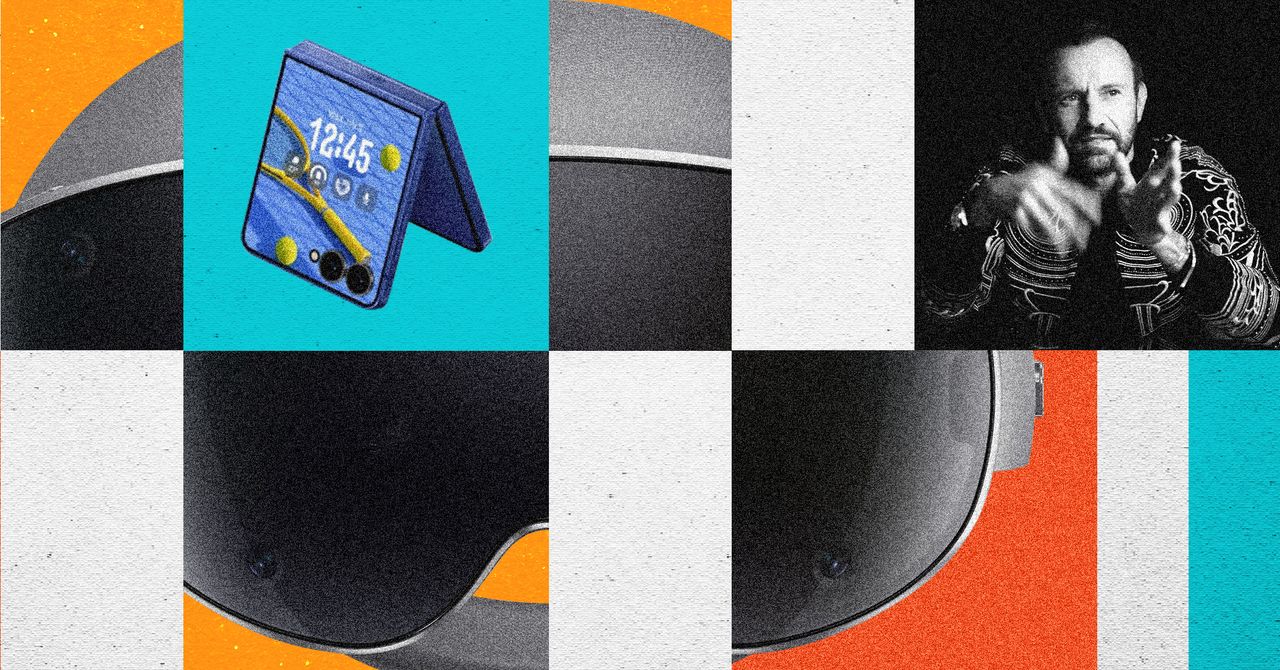Tech
The Pepsi Man Is Coming to Save Samsung From Boring Design

Samsung has one of the biggest product line ups of any tech brand, yet when it comes to design, it’s consistently seen as an “also-ran.” While other companies have forged distinctive and instantly recognizable design languages, such as Nothing, Samsung has found itself behind in the style stakes. When you’ve got Apple as one of your biggest competitors, that’s not a great position to be in.
That’s not to say there haven’t been improvements in the last decade, and the occasional flashes of promise—most notable in its collaborations with external designers, like the Bouroullec brothers, who fashioned the Serif TV for the South Korean company. But that hasn’t stopped complaints of boring and unoriginal design, both internally and externally, and an inertia when it has led, leaving other companies to close the gap.
Being defined by performance over personality has hardly done Samsung’s bottom line any harm—it recently regained its lead from Apple in global smartphone market share and has been the global leader in TVs for almost two decades. But, in 2025, it looks there’s finally a clear desire from Samsung to bridge the gap between form and function, by giving design the focus it’s been lacking for far too long at the company.
Back in April, Samsung hired Mauro Porcini, its first ever chief design officer. Porcini has spent more than 20 years building award-winning design teams at 3M and PepsiCo, most recently leading a successful global rebrand for Pepsi—the company’s first in 14 years.
For a company as big as Samsung, this hire feels late. Apple created the same position for Jony Ive a decade ago, around the same time it was reported that innovation at Samsung was being stifled beneath layers of management. With those structural issues supposedly unpicked, Samsung now has work to do—something Porcini is keen to acknowledge.
Late to the Party
“We are in a moment of change, where the way people interact with any kind of machine or electronic device is going to be radically different in the coming years,” Porcini tells me. “These machines will change the way people live, work, and connect with each other—the way people fulfil their needs. For a company like Samsung, having design at the top, involved in the way you define the future of the portfolio based on those needs—it’s more important than ever.”
The march of AI is, of course, a helpful hook upon which to tie this long overdue move, but Yves Béhar, the founder and principal designer at Fuseproject who worked with Samsung on The Frame TV, tells me this has been years in the making, and something Samsung had initially looked externally to help put the wheels in motion.
“When we started working with Samsung on The Frame [released in January 2017], the CEO at the time, HS Kim, came to us and said—look, we want to transform ourselves from a consumer technology company, into an experience business,” says Béhar. “So we helped them set some principles around that, and worked on getting that message out into the business—of what it means to think about experience versus tech. This is exactly what we did with The Frame TV.”
Tech
AT&T Gives the Smart Home a Second Try With Help From Google and Abode

AT&T is taking a second crack at the smart home. After sunsetting its Digital Life service in 2022—powered by the now-defunct 3G network—the company is launching a new smart-home security platform called Connected Life, this time in partnership with smart-home players Google and Abode.
Previously available as a pilot program in select markets, AT&T Connected Life is rolling out nationwide starting today. The vision behind it is to simplify smart-home setup. Instead of buying various smart-home devices and using multiple apps to connect them, you can buy one of two kits directly from AT&T’s Connected Life website—the Starter Kit ($11 per month for 36 months) or the Advanced Kit ($19 per month for 36 months). You can also pay upfront for the kits at $399 and $699, respectively.
Each includes Google Nest smart-home products and security sensors, with the Advanced Kit offering more sensors, a security keypad, and a Nest Cam security camera. (Google confirmed the Nest products on offer are not the latest devices the company launched recently.) You’ll use the Connected Life app and the Google Home app to set everything up, though you can also get help from a technician if you don’t want to DIY.
Google says the platform leverages Google Home’s application programming interface (API) to integrate Google’s smart home devices into the Connected Life app, and after setup, users can solely rely on the Connected Life app to view livestreams and manage devices.
There are two subscription tiers: Essential ($11 per month) or Professional ($22 per month). They offer access to features like 30-day event video history and intelligent alerts, though the Professional plan includes a US-based monitoring service from Abode that can dispatch police and medical services during emergencies. The system is designed so that you can pause professional monitoring when you don’t need it, rather than being locked into a contract.
AT&T is touting the Cellular Backup feature in Connected Life: If your home internet goes offline, this feature will keep your smart-home devices running by routing data through your smartphone (via the hot spot), and there’s a battery backup for the hub in case power goes out. This was a cornerstone feature of AT&T’s old Digital Life service, but cellular backup is now a staple in many smart-home security systems, like those from SimpliSafe or ADT.
You need to be an AT&T customer to use the Connected Life platform, though it doesn’t matter if you have a wireless mobile plan or home internet. This means the potential customer base for these new smart-home services is massive; AT&T has 119 million wireless mobile customers and is the largest provider of fiber home internet in the US, with more than 10 million customers.
Tech
Operation Bluebird Wants to Bring ‘Twitter’ Back to Life

A Virginia startup calling itself Operation Bluebird announced this week that it has filed a formal petition with the US Patent and Trademark Office, asking the federal agency to cancel X Corporation’s trademarks of the words “Twitter” and “tweet” since X has allegedly abandoned them.
“The TWITTER and TWEET brands have been eradicated from X Corp.’s products, services, and marketing, effectively abandoning the storied brand, with no intention to resume use of the mark,” the petition states. “The TWITTER bird was grounded.”
If successful, two leaders of the group tell Ars, Operation Bluebird would launch a social network under the name Twitter.new, possibly as early as late next year. (Twitter.new has created a working prototype and is already inviting users to reserve handles.)
Neither X Corporation nor its owner Elon Musk immediately responded to Ars Technica’s request for comment.
Michael Peroff, an Illinois attorney and founder of Operation Bluebird, said that in the intervening years, more Twitter-like social media networks have sprung up or gained traction—like Threads, Mastodon, and Bluesky. But none have the scale or brand recognition that Twitter did prior to Musk’s takeover.
“There certainly are alternatives,” Peroff said. “I don’t know that any of them at this point in time are at the scale that would make a difference in the national conversation, whereas a new Twitter really could.”
Similarly, Peroff’s business partner, Stephen Coates, an attorney who formerly served as Twitter’s general counsel, said that Operation Bluebird aims to re-create some of the magic that Twitter once had.
“I remember some time ago, I’ve had celebrities react to my content on Twitter during the Super Bowl or events,” he told Ars. “And we want that experience to come back, that whole town square, where we are all meshed in there.”
Could It Work?
Elon Musk bought Twitter in 2022 for $44 billion. He eventually changed the company name and brand identity from Twitter to X. That decision, Operation Bluebird says, created an opening for the Twitter name to be formally abandoned.
In July 2023, Musk himself tweeted that “we shall bid adieu to the twitter brand, and gradually, all the birds.”
That was when Peroff, a Chicago-area attorney specializing in trademark and IP law, saw an opportunity not only to claim the name Twitter but also to use the iconic illustrated logo that was affectionately referred to internally as “Larry Bird.”
Tech
With a Spike in RAM Prices, Now Might Be the Best Time to Buy a Laptop

Tariffs. Inflation. Historic corporate shake-ups and mergers. With all the factors the tech industry is facing, you might think the price of a common product like a laptop would have risen this year. But just the opposite has been happening.
I’ve been watching laptop prices slowly drop throughout 2025, a trend that peaked during Black Friday and Cyber Monday. Regardless of the state of the economy, I feel like I can say that laptop prices have never been lower. Some of my favorite laptops have recently offered significant price cuts across Macs, Windows, and Chromebooks. In a time when money is tight for so many of us, that’s welcome news. But with a RAM shortage brewing behind the scenes, there’s good reason to think it won’t last for much longer.
Just Look at the MacBook
Photograph: Brenda Stolyar
There’s one perfect example to demonstrate my point: the MacBook Air. For years now, the latest MacBook has been sold at $999. In 2022, Apple briefly bumped the price of the M2 version to $1,199 but kept the previous-gen M1 MacBook Air for $999. The last MacBook to be sold for less than $999 was in 2015, when Apple had an 11-inch model for $899. That’s a long time to stay static, considering how much more nearly everything in your life costs today than it did in 2015.
Don’t forget the discounts. The M4 MacBook Air is the latest model, and it dropped to $749 in November at retailers like Best Buy, Amazon, and Walmart. Before that, it was selling for $800 for many months. That’s an incredible price for this laptop, especially since the starting configuration comes with 16 GB of RAM.
Apple has offered a supply of older models through third-party retailers. Walmart briefly dropped the price of the M1 MacBook Air to $499. These aren’t refurbished or used; they’re new. That alone is unusual for Apple. There was a time when Apple was seen as the overpriced alternative. But for modern, entry-level Macs, that’s just not true anymore. Even the brand-new M5 MacBook Pro got an unprecedented $150 discount on Black Friday, just a month after it was announced, and that discount is still in place today.
-

 Business1 week ago
Business1 week agoCredit Card Spends Ease In October As Point‑Of‑Sale Transactions Grow 22%
-

 Politics5 days ago
Politics5 days ago17 found dead in migrant vessel off Crete: coastguard
-

 Business1 week ago
Business1 week agoAsian stocks today: Markets trade mixed ahead of US economic data; HSI nears 1% loss; Nikkei adds over 800 points – The Times of India
-
Uncategorized1 week ago
[CinePlex360] Your site has updated to WordPres
-

 Sports6 days ago
Sports6 days agoAustralia take control of second Ashes Test | The Express Tribune
-

 Tech1 week ago
Tech1 week agoNew control system teaches soft robots the art of staying safe
-

 Fashion3 days ago
Fashion3 days agoGermany’s LuxExperience appoints Francis Belin as new CEO of Mytheresa
-

 Entertainment1 week ago
Entertainment1 week agoSabrina Carpenter recalls ‘unbelievable’ experience with pal Taylor Swift














